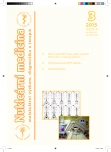Dobutamine test and myocardial SPECT
Authors:
Drahoslava Nováková 1; Jaroslav Šipula 2; Radoslava Drozdková 1; Otakar Kraft 1; Martin Havel 1
Authors‘ workplace:
Klinika nukleární medicíny, LF OU a FN Ostrava
1; Kardiovaskulární centrum, LF OU a FN Ostrava
2
Published in:
NuklMed 2015;4:51-59
Category:
Review Article
Overview
Aim:
To give information about a dobutamine test and a myocardial SPECT performed in cooperation with the Department of functional diagnostics (DFD).
Methods:
Conditions to perform this test were made possible in 1996 when the separate Department of nuclear medicine (DNM) was introduced near the DFD (part of Cardiovascular center of Univ Hosp Ostrava). Requests are sent by specialists (internist, cardiologist, cardiosurgeon) to the DFD. Date of examination is notified to the separate DNM where patient is admitted and intravenous line is applied. The patient is than transferred to DFD together with medical record. Dobutamine test is performed by cardiologist. Radiopharmaceutical (99mTc-MIBI, 99mTc-tetrofosmin) is injected by nuclear medicine physician at the time of achieving appropriate heart rate. After finishing the test the patient is transferred back to DNM to perform gated SPECT. The rest examination is required at least 24 hours later if some pathology is detected on the stress examination. Final reports are interchanged.
Conclusion:
Extent and severity of perfusion abnormalities can be automatically quantified thanks to new cardiac softwares. Dobutamine test is the most widely used non-invasive stress test, it is highly specific for detection of patients with inducible myocardial ischemia. Both tests are currently complementary diagnostic methods used for diagnosis of coronary artery disease (CAD); risk stratification, prognosis assessment and selection of following therapy in patients with known CAD. Simultaneous performance of dobutamine test and myocardial SPECT has cardinal benefit for patient management.
Key Words:
dobutamine, gated SPECT, echocardiography, CAD
Sources
1. Chaloupka V, Elbl.L. Zátěžová echokardiografie. Praha, Maxdorf, 1997, 126 p
2. Lang O, Kamínek M, Trojanová H. Nukleární kardiologie. Praha, Galén, 2008, 130 p
3. Pleva M, Ouředníček P. MRI srdce: praktické využití z pohledu kardiologa. Praha, Grada, 2012, 133 p
4. Niederle P et al. Echokardiografie - 2. vydání. Praha, Triton, 2005, 359 p
5. Chaloupka V. Zátěžové testy v kardiologii - Zátěžová elektrokardiografie. - 15. Česká kardiologická společnost [online] [cit. 2015-05-03]. Dostupné na: http://www.kardio-cz.cz/index.php?&desktop=clanky&action=view&id=95
6. Mysliveček M, Kamínek M. Doporučení k provádění zátěžových testů v nukleární kardiologii. Cor et vasa 2000;42:K54-K56
7. Sovová E, Sedlářová J. Kardiologie pro obor ošetřovatelství - 2., rozšířené a doplněné vydání. Praha. Grada, 2014, 255 p
8. Gandalovičová J. Hibernující myokard a jeho význam pro klinickou praxi. Interní medicína pro praxi 2002;4:238-242
9. O´Rourke RA., Walsh RA, Fuster V et al. Kardiologie: Hurstův manuál pro praxi - 12. vydání. Praha, Grada, 2010, 767 p
Labels
Nuclear medicine Radiodiagnostics RadiotherapyArticle was published in
Nuclear Medicine

2015 Issue 3
Most read in this issue
- Dobutamine test and myocardial SPECT
- Bone SPECT image reconstruction using deconvolution and wavelet decomposition
